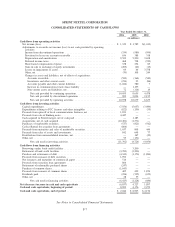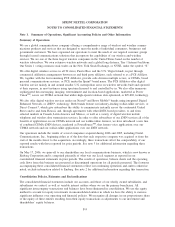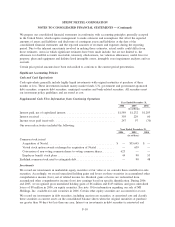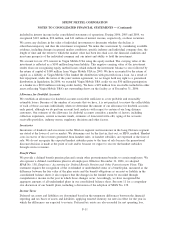Sprint - Nextel 2006 Annual Report Download - page 89
Download and view the complete annual report
Please find page 89 of the 2006 Sprint - Nextel annual report below. You can navigate through the pages in the report by either clicking on the pages listed below, or by using the keyword search tool below to find specific information within the annual report.capital loss and tax credit carryforwards. We are required to estimate the amount of taxes payable or
refundable for the current year and the deferred income tax liabilities and assets for the future tax
consequences of events that have been reflected in our consolidated financial statements or tax returns for each
taxing jurisdiction in which we operate. This process requires management to make assessments regarding the
timing and probability of the ultimate tax impact. We record valuation allowances on deferred tax assets if we
determine that it is more likely than not that the asset will not be realized. Additionally, we establish reserves
for uncertain tax positions based upon our judgment regarding potential future challenges to those positions.
See note 12 for more information.
Property, Plant and Equipment
We record property, plant and equipment, or PP&E, including improvements that extend useful lives, at cost.
PP&E primarily includes network equipment and software, buildings and improvements, non-network internal
use software, network asset inventory and construction in progress, and office equipment. Network equipment
and software includes switching equipment and cell site towers, base transceiver stations, other radio frequency
equipment, internal use software, digital fiber-optic cable, conduit, transport facilities, and transmission-related
equipment. Buildings and improvements principally consists of owned general office facilities, leasehold
improvements and retail stores. Non-network internal use software, office equipment and other primarily
consists of furniture, information technology equipment and vehicles. Network asset inventory and construction
in progress primarily includes materials, transmission and related equipment, labor, engineering, site develop-
ment, interest and other costs relating to the construction and development of our network. Assets under
construction are not depreciated until placed into service. Capitalized interest incurred in connection with the
construction of capital assets totaled $113 million in 2006, $53 million in 2005 and $56 million in 2004.
Repair and maintenance costs are expensed as incurred.
We capitalize costs for network and non-network software developed or obtained for internal use during the
application development stage. These costs are included in property, plant and equipment and, when the
software is placed in service, are depreciated over estimated useful lives of up to ten years. Costs incurred
during the preliminary project stage, as well as maintenance and training costs, are expensed as incurred.
The cost of PP&E generally is depreciated on a straight-line basis over estimated economic useful lives.
Amortization of assets recorded under capital leases is recorded in depreciation expense. We depreciate
leasehold improvements over the shorter of the lease term or the estimated useful life of the respective assets.
We depreciate buildings, network equipment and software over estimated useful lives of up to 31 years, with
about 66% of those assets being depreciated between five and 15 years, and office equipment and other
depreciable property, plant and equipment over estimated useful lives of up to 12 years, with about 85% of
those assets being depreciated between three and five years. We calculate depreciation on certain of our assets
using the group life method; accordingly, ordinary asset retirements and disposals are charged against
accumulated depreciation with no gain or loss recognized.
Since changes in technology or in our intended use of these assets, as well as changes in broad economic or
industry factors, may cause the estimated period of use of these assets to change, we perform annual internal
studies to confirm the appropriateness of depreciable lives for most categories of PP&E. These studies utilize
models, which take into account actual usage, physical wear and tear, replacement history, and assumptions
about technology evolution, to calculate the remaining life of our asset base. When these factors indicate the
useful lives of PP&E are different from the original assessment, we depreciate the remaining book values
prospectively over the adjusted estimated useful lives. In addition to performing our annual studies, we also
continue to assess the estimated useful life of the iDEN network assets, which had a net carrying value of
$7.4 billion as of December 31, 2006, and our future strategic plans for this network, as a larger portion of our
subscriber base is served by our CDMA network. A reduction in our estimate of the useful life of the iDEN
network assets would cause increased depreciation charges in future periods that could be material.
F-12
SPRINT NEXTEL CORPORATION
NOTES TO CONSOLIDATED FINANCIAL STATEMENTS — (Continued)
























